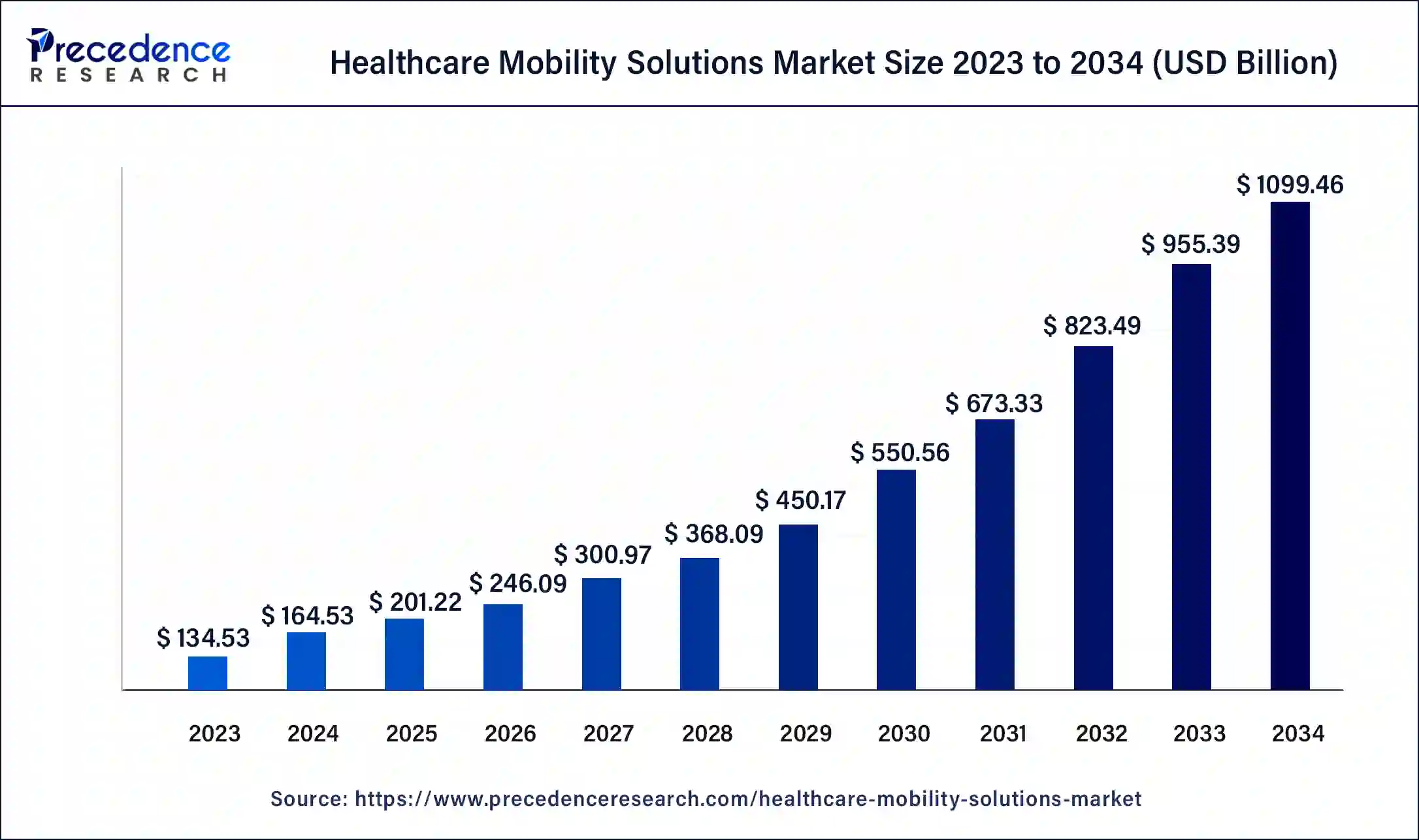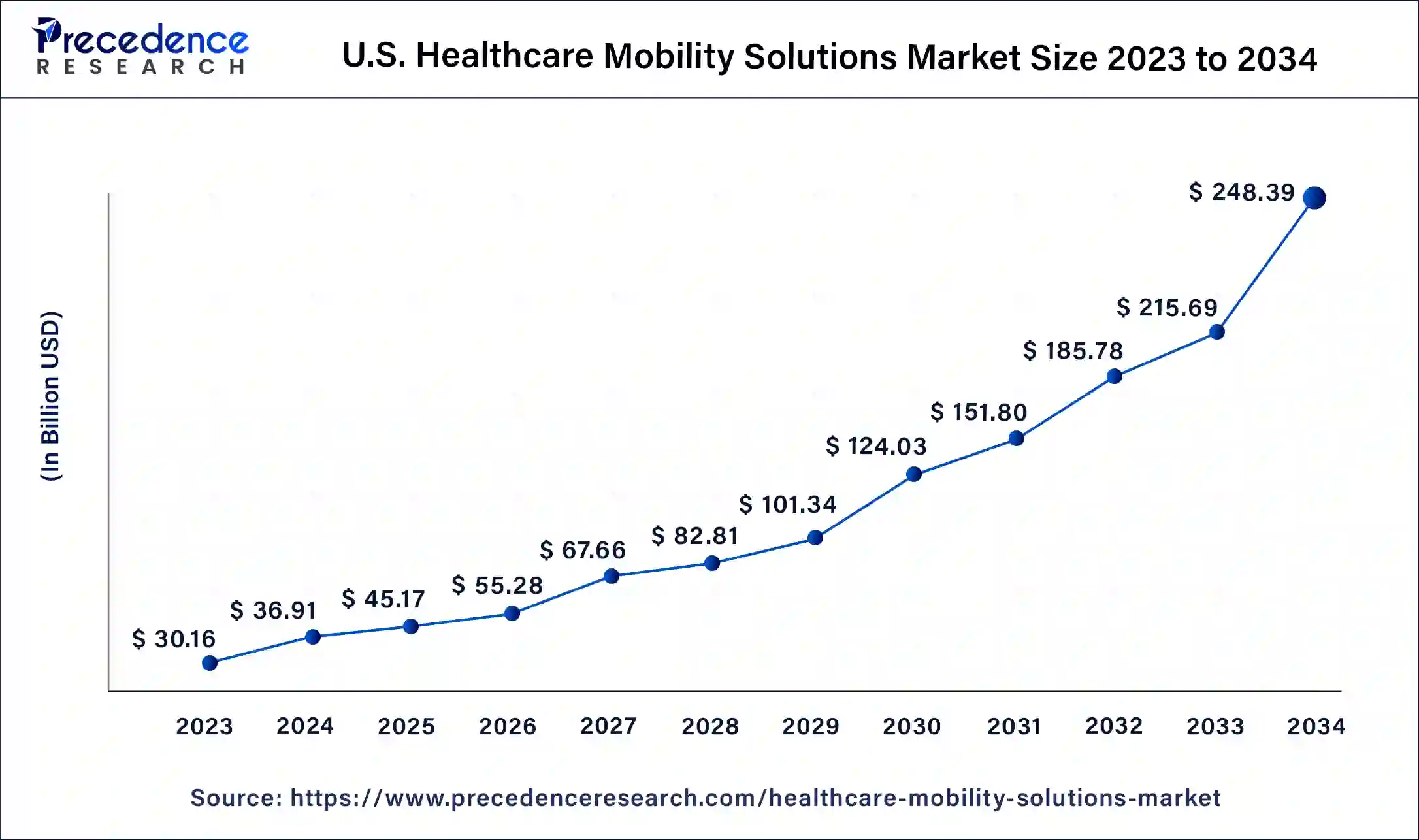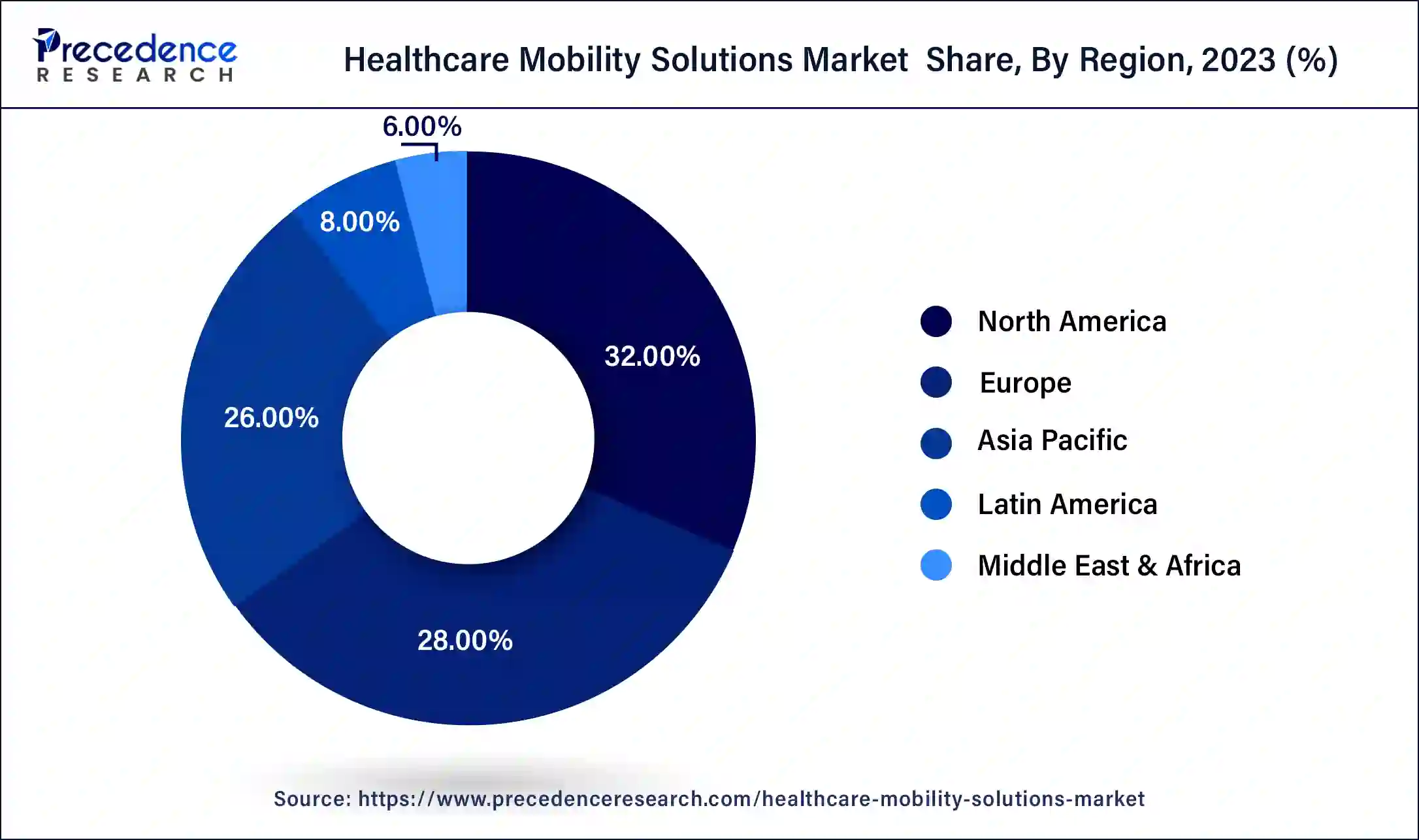What is the Healthcare Mobility Solutions Market Size?
The global healthcare mobility solutions market size is calculated at USD 201.22 billion in 2025 and is predicted to increase from USD 246.09 billion in 2026 to approximately USD 1235.42 billion by 2035, expanding at a CAGR of 19.90% from 2026 to 2035.

Market Highlights
- North America dominated the healthcare mobility solutions market with the largest market share of 32% in 2025.
- Asia Pacific is expected to grow with the fastest CAGR in the market during the forecast period.
- By application, the enterprise solution segment dominated the market in 2025.
- By application, the mHealth segment is projected to grow rapidly in the market in the coming years.
- By end user, the providers segment held the largest share of the market in 2025.
- By end user, the patients segment is projected to grow rapidly in the market in the upcoming years.
What are Healthcare Mobility Solutions?
Healthcare mobility solutions involve the use of mobile devices to detect or monitor biological changes in the human body. These solutions effectively provide enhanced patient care in the least possible time and reduce healthcare costs. The market is majorly fueled by the rising demand for quality healthcare solutions among patients. These solutions enhance patient care and improve overall health outcomes. Moreover, the rising technological developments, such as the Internet of Things, artificial intelligence, and cloud computing, rising emphasis on patient-centric care, increasing regulatory mandates and government efforts, increasing requirement for remote patient monitoring, and growing adoption of mobile devices are expected to boost the market during the forecast period.
How is AI contributing to the Healthcare Mobility Solutions Industry?
Artificial Intelligenceis involved in mHealth solutions for the healthcare mobility solutions industry by spreading the use of telehealth, remote monitoring, and wearable devices and sensors, thus making patient health tracking more sophisticated and better monitored. The AI-powered analytics process enhances the quality of choices made, resource distribution gets optimized, and the application of early intervention measures is made possible in case of complication prevention.
The aforementioned advancements through the use of technology attract more trained and paid caregivers, and patient-customized care is technologically connected, thus driving the spread of digital health in the whole healthcare system.
Healthcare Mobility Solutions MarketGrowth Factors
The healthcare industry is changing dramatically, as it has been one of the early users of advanced mobile technology in its products and services. With the help of fast realization of the benefits provided by the mobile applications, healthcare professionals have solved the majority of the problems they face. Many obstacles have hampered the healthcare sector such as rising overhead costs, remote area locations, and complex regulatory requirements all of which had a significant impact on their overall services. The healthcare sector has to overcome all these obstacles with new and innovative technologies and solutions.
The healthcare mobility refers to the use of mobile applications, mobile devices, and enterprise platforms to communicate securely and more efficiently and effectively share clinical data among various end users such as healthcare providers, payers, and patients. The healthcare mobility also refers to technological advancements in the field of healthcare that allow for the provision of medical and healthcare services such as remote monitoring, telemedicine, and virtual diagnosis.
The reach and accessibility of expensive business and clinical systems are improving due to mobility in healthcare. The mobility has emerged as a critical technology for the healthcare business in recent years since it allows the medical community to adopt a patient-centric strategy while reducing healthcare expenses and the consequences of nursing and healthcare worker shortages.
Market Outlook
- Industry Growth Overview: The use of telemedicine and remote monitoring is increasing, leading to the adoption of healthcare mobility across medical environments.
- Sustainability Trends:Digital mobility results in less use of resources, while the AI optimization brings about higher efficiency with lower operational costs.
- Global Expansion:North America is the frontrunner in the adoption, while the Asia Pacific is speeding up the process through investment in mobile-based healthcare advancements.
- Major Investors:The list includes Philips, IBM, Microsoft, Cisco, Oracle, Sequoia Capital, and Matrix Partners, who are all committed to market share expansion through innovation.
- Startup Ecosystem:The digital-first healthcare startups are getting global funding and cooperative regulatory frameworks, thus their rapid scalability.
Market Scope
| Report Coverage | Details |
| Market Size in 2025 | USD 201.22 Billion |
| Market Size in 2026 | USD 246.09 Billion |
| Market Size by 2035 | USD 1235.42 Billion |
| Market Growth Rate from 2026 to 2035 | CAGR of 19.90% |
| Largest Market | North America |
| Base Year | 2025 |
| Forecast Period | 2026 to 2035 |
| Segments Covered | Product & Services, Application, End User, and Region |
| Regions Covered | North America, Europe, Asia-Pacific, Latin America, and Middle East & Africa |
Market Dynamics
Drivers
Increasing adoption of smartphones
One of the primary factors fueling the growth of the healthcare mobility solutions market is the increasing usage of smartphones among the population. The market is expanding at a rapid pace due to the rising demand for patient health tracking applications and the increasing usage of connected devices to improve the quality of healthcare solutions. The surge in demand for healthcare mobility solutions is mainly due to their cost-effectiveness and ease of use, resulting in improved workflow.
- For instance, globally, around 1.39 billion smartphones were sold in 2022, and 1.34 billion units were sold in 2023. There are approximately 6.84 billion smartphones and 10.47 billion Internet of Things connections worldwide.
Restraint
High Cost
A lack of communication protocols and reimbursement policies are projected to hamper the growth of the healthcare mobility solutions market. Cost concerns, as well as the short battery life of mobiles, tablets, and computers, deter potential users from adopting these solutions, thereby restraining the market.
Opportunity
Innovation and product diversification strategies
Major companies competing in the market are developing innovative products, including remote patient monitoring solutions, to increase revenue and sales and address larger customer bases. Remote patient monitoring solutions allow healthcare providers to track and monitor medical data and patients' health from remote locations. These solutions also enable physicians to create personalized care plans, propelling the market.
Healthcare Mobility Solutions Market Segment Insights
Product & Services Insights
Mobile devices dominate the healthcare mobility solutions market during the forecast period. This is owing to growing acceptance of mobile equipment such as tablets and smartphones as well as the widespread availability of reliable mobile networks, which encourages the usage of these devices.
On the other hand, the mobile applications segment is expected to grow at rapid pace during the forecast period. The use of mobile applications to promote information about the preventative, causative, and therapeutic agents of chronic diseases has proven to be quite beneficial.
Application Insights
The enterprise solution dominates the healthcare mobility solutions market during the forecast period. This is due to increased need for safe and cost-effective corporate solutions. The factors such as increased demand for improved operational efficiency, operational cost reduction, and internal procedure optimization.
The mHealth applications segment is expected to grow at rapid pace during the forecast period. The accompanying benefits of using these applications such as improving patient engagement in the medical delivery system, meeting consumer demand, and securely sharing information are projected to drive the growth of the segment.
End Use Insights
The providers dominate the healthcare mobility solutions market during the forecast period. This is attributed to the widespread of business mobility solutions in hospitals for managing, treating, monitoring patients' health online, preserving electronic health records, and delivering medical education.
On the other hand, the patients segment is expected to grow at rapid pace during the forecast period. The patients play vital role in the healthcare mobility solutions market. These solutions help patients to track their health with the help of mobile devices and applications.
Healthcare Mobility Solutions Market Regional Insights
The U.S. healthcare mobility solutions market size reached USD 45.17 billion in 2025 and is predicted to be worth USD 279.23 billion by 2035, at a CAGR of 19.98% between 2026 to 2035.

U.S. Healthcare Mobility Solutions Market Trends
The U.S. is the most innovative country in adopting mobility in the healthcare sector, focusing on new high-security and technology upgrades. The introduction of AI-enabled systems is the cause of improved clinical efficiency and remote patient engagement.
North America segment dominated the global healthcare mobility solutions market in 2023, in terms of revenue and is estimated to sustain its dominance during the forecast period. This is attributed to the favorable government measures relating to the use of mHealth applications in hospitals. As a result, increasing mHealth applicationpenetration in this region is a crucial contributor to the growth of the healthcare mobility solutions market during the forecast period.
The North America region is the one that gets most of the benefit from tech companies' digital adaptation. Hospitals in the area are also very advanced, and digital security measures have been put in place and which is the reason for the digital growth.

The Asia-Pacific is estimated to be the most opportunistic segment during the forecast period. This is due to increased awareness among end users and increased use of mHealthapplications by healthcare providers.
Asia Pacific moves forward with good digital healthcare mobility acceptance. Growing health consciousness, along with technology-driven care, makes remote consultation more accessible. The government powers the use of mobile apps and digital workflows to cater to the increasing demand for easy-to-consumer healthcare solutions.
China Healthcare Mobility Solutions Market Trends
China's rapid growth is supported by healthcare digitization and the adoption of mobile consultations. The huge population calls for the increased deployment of mobile platforms for remote healthcare access and patient management, thus creating the prospects for integrated smart health services.
Europe is becoming a region where modern healthcare is assisted by eHealth and clinical mobility running systems. Every effort is possible through the strong regulations that have been put in place to ensure good hospital support for digital integration and secure mobility.
The UK Healthcare Mobility Solutions Market Trends
The UK experiences growth attributable to the high usage of tablets and smartphones in the healthcare sector. The public support for digital projects in the healthcare sector helps to enhance the movement of clinicians, accelerate access to records, remote care, and hospitals and primary care settings.
Healthcare Mobility Solutions Market-Value Chain Analysis
R&D: Uncovering new substances and carrying out initial safe research
- Key Players: Pfizer, Johnson & Johnson, Merck, and GSK
Clinical Trials & Regulatory Approvals: Test on humans followed by approval from the authorities.
- Key players: IQVIA, ICON Plc, Parexel, and PPD
Formulation & Final Dosage Preparation: Making a drug into a stable and easy-to-use dosage form.
- Key Players: Sun Pharmaceutical Industries, Cipla, and Dr. Reddy's Laboratories
Packaging & Serialization: Safe packing with a tracking system to verify genuineness.
- Key Players: Amcor plc, Gerresheimer AG, Schott AG, and Becton Dickinson (BD)
Distribution: Transporting the finished products to hospitals, pharmacies, and care sites.
- Key players: McKesson Corporation
Top Companies in the Healthcare Mobility Solutions Market & Their Offerings
- Oracle Corporation:Offers cloud-based healthcare supply and inventory management with the help of automated tracking systems that streamline access and workflow.
- McKesson Corporation: Healthcare IT solutions, including medication management systems and distribution services, are provided by the company, and they make the clinical supply chains and authorization processes more efficient.
- Zebra Technologies: Identifies the need for smart mobile devices that have data capture and asset tracking that allow instant communication in the clinic and patient care to be done in cooperation.
Other Major Companies
- Philips Healthcare
- Cisco Systems
- Omron Corporation
- Cerner Corporation
- SAP SE
- AT&T Inc.
- Airstrip Technologies
Recent Developments
- In September 2025, the Taiwan Excellence Pavilion launched innovative products at Taiwan Expo India 2025. This innovation features eight Taiwanese brands showcasing technologies in ICT, healthcare, industrial solutions, gadgets, and mobility. (Source: smestreet.in)
- In June 2025, Sunrise Medical launched seven innovative mobility products at its Elite Dealer event in Warwickshire, showcasing brands like Magic Mobility, Empulse, Sterling, and Quickie to over 100 prescribers. The event was hosted at Warwickshire Walton Hall Hotel & Spa. (Source: attoday.co.uk)
- In April 2024,Health Tech Solutions Group, a provider of healthcare solutions, such as personalized patient care, telemedicine, and mobile health services outside traditional hospital settings, announced its official UK launch. The company is raising GBP 3 million in investment to activate seven further locations in the UK and Ireland by the end of 2025, with the capacity to service more than 100,000 patients annually.
- In March 2024, GCX, a frontrunner in medical mounts for healthcare IT solutions, introduced the GCX Tablet Roll stand to ensure secure and safe access to medical records and patient services anywhere in the hospital. This easily maneuverable cart, with a variable or fixed-height tablet arm, optimizes viewing and access to patient services, electronic medical records, and video conferencing.
- In February 2024, SOTI, a global leader in enterprise mobility management (EMM) solutions, launched the SOTI XSight Live View, a revolutionary tool to visualize business and mobile device data in real-time.
Healthcare Mobility Solutions MarketSegments Covered in the Report
By Product & Services
- Mobile Devices
- Mobile Computers
- RFID Scanners
- Barcode Scanners
- Others
- Mobile Applications
- Enterprise Mobility Platforms
By Application
- Enterprise Solutions
- Patient Monitoring
- Case Management
- Medication Administration
- Patient Id (PPID)/Patient Tracking
- Specimen Collection and Tracking
- Dietary and Nutrition
- Infectious Disease Monitoring/Field Data Collection
- Other Patient Care Management Solutions
- Patient Admissions/Discharge
- Revenue Management/Billing
- Claims Processing
- Asset and Facilities Management
- Materials Management
- Others
- Scheduling
- Time and Attendance Management
- Other Operations Management Solutions
- Patient Care Management
- Operations Management
- Workforce Management
- mHealth Applications
- Chronic Care Management
- Exercise
- Weight Loss
- Women�s Health
- Sleep Monitoring
- Medication Management
- Other mHealth Applications
By End Use
- Payers
- Providers
- Hospitals
- Laboratories
- Others
- Patients
By Region
- North America
- Europe
- Asia-Pacific
- Latin America
- Middle East & Africa (MEA)
For inquiries regarding discounts, bulk purchases, or customization requests, please contact us at sales@precedenceresearch.com
Frequently Asked Questions
Ask For Sample
No cookie-cutter, only authentic analysis – take the 1st step to become a Precedence Research client




 sales@precedenceresearch.com
sales@precedenceresearch.com
 +1 804-441-9344
+1 804-441-9344